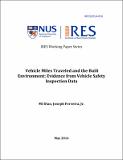Vehicle miles traveled and the built environment: evidence from vehicle safety inspection data
Author(s)
Diao, Mi; Ferreira, Joseph, Jr.
DownloadFerreira_Vehicle miles.pdf (1.729Mb)
OPEN_ACCESS_POLICY
Open Access Policy
Creative Commons Attribution-Noncommercial-Share Alike
Terms of use
Metadata
Show full item recordAbstract
This study examines the linkage between household vehicle usage and their residential locations within a metropolitan area using a newly available administrative dataset of annual private passenger vehicle safety inspection records (with odometer readings) and spatially detailed data on the built environment. Vehicle miles travelled (VMT) and a set of comprehensive built-environment measures are computed for a statewide 250×250 m grid cell layer using advanced geographic information systems and database management tools. We apply factor analysis to construct five factors that differentiate the built-environment characteristics of the grid cells and then integrate the built-environment factors into spatial regression models of household vehicle usage that account for built environment, demographics, and spatial interactions. The empirical results suggest that built-environment factors not only play an important role in explaining the intraurban variation of household vehicle usage, but may also be underestimated by previous studies that use more aggregate built-environment measures. One-standard-deviation variations in the built-environment factors are associated with as much as 5000-mile differences in annual VMT per household. This study also demonstrates the potential value of new georeferenced administrative datasets in developing indicators that can assist urban planning and urban management.
Date issued
2014Department
Massachusetts Institute of Technology. Department of Urban Studies and PlanningJournal
Environment and Planning A
Publisher
Pion Ltd.
Citation
Diao, Mi, and Joseph Ferreira Jr. “Vehicle Miles Traveled and the Built Environment: Evidence from Vehicle Safety Inspection Data.” Environment and Planning A 46, no. 12 (2014): 2991–3009.
Version: Author's final manuscript
ISSN
0308-518X
1472-3409